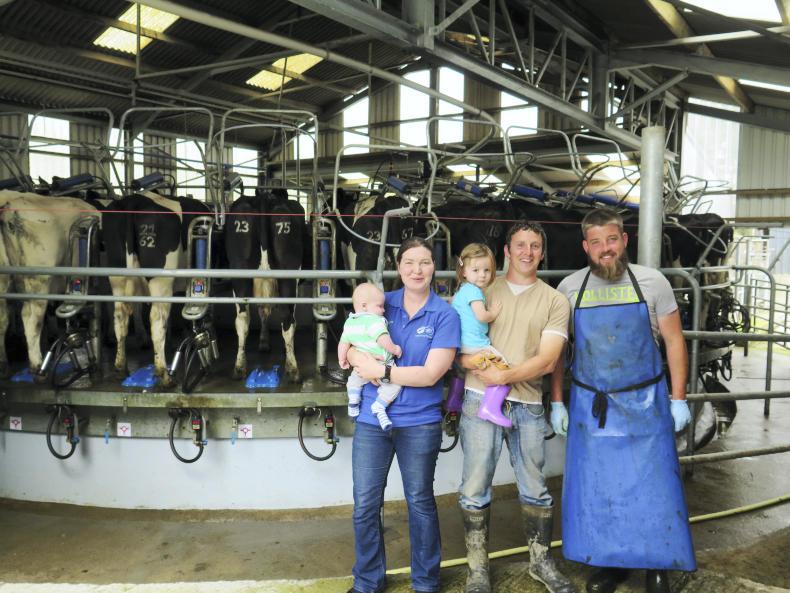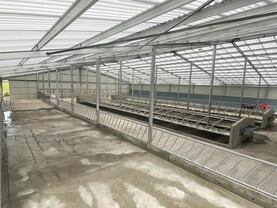When looking at upgrading milking facilities, at what point does a rotary milking parlour outweigh a herringbone?
This was the question posed by Bryan and Gail Daniels when their herd outgrew their 22-unit herringbone parlour.
The capital costs of installing a rotary parlour are higher than a herringbone but on the flip side, rotary parlours are more labour efficient than herringbones, as one operator can milk a few hundred cows on a rotary, while it takes two or more operators to milk in large herringbones.
This year, Bryan and Gail are milking 260 cows, having increased from 236 cows milked in 2016. Cow numbers have increased steadily on the Daniels’ farm prior to and since milk quota abolition.
Next year, the plan is to milk 300 cows with 340 cows planned for 2019. The increase in cow numbers is all hinged around the fact that the Daniels have a large land base.
The map in the farm office says it all. The farm consists of 140ha and while it is in two blocks, both blocks can be accessed by the herd.
So there is lots of potential to increase cow numbers. The original farm was doubled in size by Bryan’s father.
Too soon
“In terms of the development of the farm, building the rotary now was probably two or three years too soon as cow numbers are not up to where they need to be to justify the rotary.
"That said, we didn’t see the point of slogging it out in the old parlour for another two or three years and then put in a rotary.
"With a young family, sustainability for ourselves and people working on the farm is important to us,” Bryan says.

The decision to install a rotary was made in March 2016. April was spent looking at the different makes and the different options. A deal was made with DeLaval in April for a 44-point rotary. Work began in July.
Renovations
Bryan’s existing parlour was a 22-unit DeLaval and this was cut out at floor level and moved on wheels into the cubicle shed and put on blocks.
This temporary parlour was used to milk the cows until the end of the year. The pit was at floor level so the cows had to step up to be milked and step down after milking.
The new rotary was built on the same location as the old parlour, meaning the dairy and collecting yard were already in place.
The old parlour was originally a four-unit and then a 10-unit, but this was expanded to a 22-unit in 2007.
When it was extended a much bigger shed was built at the back and most of the rotary fits in to this area now. The shed was widened at the side and back to take the rotary.

Work on the rotary began in early August 2016 with the demolition of most of the old parlour and the widening of the shed.
SRS in Castlecomer supplied and erected the steel. To widen the shed, three pillars were removed and replaced with a gantry and a lean-to was supported with this.
Another lean-to was put on to the back of the shed where the milker stands. The shed work cost €17,000.
The next job was to level the site and find the centre of the rotary. It is from this that every other measurement is taken, including the positioning of the round mass concrete wall on which the platform rotates.
Most of this work was done by a local builder with Bryan and the guys working on the farm providing the labour, with guidance from DeLaval.
New Zealand built
By November, the site was ready for the parlour to be installed. A team of three people came over from New Zealand to build the platform and install the plant.
“Having spent time milking in New Zealand I knew I wanted a New Zealand-built rotary because there are so many rotaries out there I think they know how to do them correctly.
"The first thing the lads commented on when they got to the farm was there was lights on the shed, meaning they could start early and work late.
"They had budgeted to be in Ireland for 11 days and that’s all they needed,” Bryan said.

The platform turned for the first time just before Christmas but Bryan and the team waited until after Christmas to start training the cows and heifers to the new system.
In terms of automation, the plant is fairly high spec, with automatic cluster removers (ACRs), dump-line, retention bars, on-platform teat-spraying, milk meters and a drafting gate. I asked Bryan why he went for the extras.
“It’s set up to be a one person parlour so ACRs are a necessity. We went with retention bars as it’s the one thing people that didn’t have them said they regret not getting.
“It means that if the cow isn’t milked out she will go around again.
"It saves clusters being damaged and it already allowed us to keep six slow cows that would have been culled otherwise.
"On-platform teat-spraying is a bit more expensive than an air ram but I think it is more accurate, especially as it has four nozzles so it gets better teat coverage."
Cell count for the year will be less than 70,000. I suppose the dump-line and milk meters were more debatable but I have a shoulder problem so I don’t want to be lugging around dump-buckets and it means we can always have just one herd.
“We have a pedigree herd of British Friesians and stock sales are an important part of the business, so having reliable milk production data is important which is why we went with the milk meters.”
Evaluation
Two-thirds of the way through its first season, Bryan and Gail are happy with the investment. Milking times have greatly reduced and Bryan and dairy farm management student Andrew Doyle can milk on their own.
It takes around one hour and 20 minutes to milk in the morning and around 50 minutes in the evening with one person.
In spring, two people milk, with one person doing preparation and the other cupping on. Roles are reversed for the evening milking.
For the breeding season, Bryan stands on the foldup vet platform where he does the tailpainting and artificial insemination (AI). He also uses this for the worm dosing and is hoping to vaccinate from it too.

The existing collecting yard with backing gate is capable of holding around 300 cows, but can be expanded in the future.
In terms of cost, including VAT and before TAMS II grant, the bill for the machine and deck was €7,500 per unit.
Including the shed, concrete floors, walls and three phase electricity (which cost €56,000) the total cost was closer to €10,000 per unit.
For a husband and wife team with a large land base on which to milk more cows and who value quality of life for themselves and employees, you would have to say that it was a good investment for them.






 This is a subscriber-only article
This is a subscriber-only article















SHARING OPTIONS: